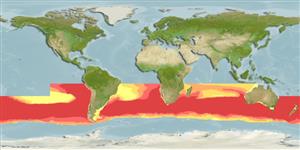Common names from other countries
分類 / Names
俗名 | 同種異名 | Catalog of Fishes(屬, 種) | ITIS | CoL | WoRMS | Cloffa
Teleostei >
Scombriformes (Mackerels)
鱸形目 (Mackerels) >
Scombridae (Mackerels, tunas, bonitos)
鯖科 (Mackerels, tunas, bonitos) > Scombrinae
Etymology: Thunnus: Greek, thynnos = tunna (Ref. 45335).
More on author: Castelnau.
Environment: milieu / climate zone / depth range / distribution range
生態學
海洋; 海洋洄游的 (Ref. 51243); 深度上下限 0 - 2743 m (Ref. 57178). 溫帶; 5°C - 20°C (Ref. 168); 10°S - 60°S, 180°W - 180°E (Ref. 54921)
Atlantic, Indian and Pacific: temperate and cold seas, mainly between 30°S and 50°S, to nearly 60°S. During spawning, large fish migrate to tropical seas, off the west coast of Australia, up to 10°S. Highly migratory species. If the current exploitation continues, the population will be below 500 mature individuals in 100 years (Ref. 27905).
大西洋,印度洋與太平洋: 溫帶與寒冷海洋, 主要地在 30個 °S 與 50個 °S 之間, 對將近 60個 ° S. 在產卵的時候,大的魚迴游到熱帶的海洋,外海的澳洲的西岸,達到 10個 ° S. 高度遷移的種,1982年海事法會議的附件一.(參考文獻 26139) 如果水流開發繼續, 族群在 100 年中將是在 500個成熟的個體之下。 (參考文獻 27905)
Length at first maturity / 大小 / 重量 / 年齡
Maturity: Lm 122.0, range 120 - 130 cm
Max length : 245 cm FL 雄魚/尚未辨別雌雄; (Ref. 5203); common length : 160 cm FL 雄魚/尚未辨別雌雄; (Ref. 9684); 最大體重: 260.0 kg (Ref. 5203); 最大年齡: 20 年 (Ref. 168)
脊椎骨: 39. A very large species, deepest near the middle of the first dorsal fin base. Swim bladder present. Lower sides and belly silvery white with colorless transverse lines alternating with rows of colorless dots. The first dorsal fin is yellow or bluish; the anal fin and finlets are dusky yellow edged with black; the median caudal keel is yellow in adults.
一個非常大的種, 深的在第一背鰭基底的中央的附近。 有泳鰾。 下側與腹面銀白色有無色的被其次為列的無色點的橫切線。 第一背鰭是黃色或藍色的; 臀鰭與離鰭是暗黃色被黑色邊緣的; 中央的尾部龍骨脊是黃色的當成魚時。
By maturity, most southern bluefin tuna lead an oceanic, pelagic existence (Ref. 6390). Spawning fish and larvae are encountered in waters with surface temperatures between 20° and 30°C. An opportunistic feeder, preying on a wide variety of fishes, crustaceans, cephalopods, salps, and other marine animals. Mostly canned (Ref. 9684). A specialized fishery for sashimi-quality has been developed recently by New Zealand fishers. In Japan, it is highly prized for the sashimi markets.
藉著成熟,大多數的南方藍鰭鮪魚帶領一個大洋性又大洋性的生存。 (參考文獻 6390) 產卵魚而且和在 20個 ° 與 30個 ° C. 之間的表面溫度在水域中仔魚被見到 一個隨機的捕食者, 捕食各式各樣的魚,甲殼動物,頭足類動物,被囊動物與其他的海洋動物。 大部份裝於罐頭。 (參考文獻 9684) 一個被特殊化的漁場用作生魚片-品質最近已經被紐西蘭漁夫發展。 在日本,它是因為高度地而被重視的生魚片市場。
It is not known whether all mature fish spawn each year, every few years, or even only once in their lifetime (Ref. 30320).大西洋,印度洋與太平洋: 溫帶與寒冷海洋, 主要地在 30個 °S 與 50個 °S 之間, 對將近 60個 ° S. 在產卵的時候,大的魚迴游到熱帶的海洋,外海的澳洲的西岸,達到 10個 ° S. 高度遷移的種,1982年海事法會議的附件一.(參考文獻 26139) 如果水流開發繼續, 族群在 100 年中將是在 500個成熟的個體之下。 (參考文獻 27905)
Collette, B.B. and C.E. Nauen, 1983. FAO Species Catalogue. Vol. 2. Scombrids of the world. An annotated and illustrated catalogue of tunas, mackerels, bonitos and related species known to date. Rome: FAO. FAO Fish. Synop. 125(2):137 p. (Ref. 168)
IUCN 瀕危狀態 (Ref. 130435)
瀕危 (EN) (A1bd); Date assessed: 15 January 2021
CITES (Ref. 128078)
Not Evaluated
人類使用
漁業: 商業性; 養殖: 商業性; 游釣魚種: 是的
工具
特別的報告
下載 XML
網路資源
Estimates based on models
Preferred temperature (Ref.
115969): 2.5 - 7.9, mean 5 (based on 439 cells).
Phylogenetic diversity index (Ref.
82804): PD
50 = 0.5039 [Uniqueness, from 0.5 = low to 2.0 = high].
Bayesian length-weight: a=0.01288 (0.01067 - 0.01556), b=3.03 (2.99 - 3.07), in cm Total Length, based on LWR estimates for this species (Ref.
93245).
營養階層 (Ref.
69278): 3.9 ±0.53 se; based on food items.
回復力 (Ref.
120179): 低的, 最小族群倍增時間4.5 - 14 年 (K=0.14-0.15; tm=8-9; tmax=20; Fec=14 million).
Prior r = 0.27, 95% CL = 0.18 - 0.41, Based on 1 full stock assessment.
Fishing Vulnerability (Ref.
59153): High to very high vulnerability (67 of 100).
Climate Vulnerability (Ref.
125649): Moderate vulnerability (38 of 100).
